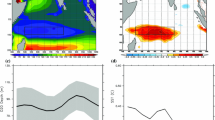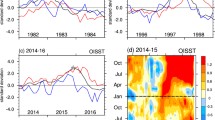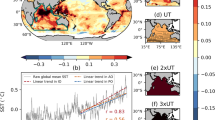Abstract
Both the tropical Indian and tropical Pacific Oceans are active atmosphere-ocean interactive regions with robust interannual variability, which also constitutes a linkage between the two basins in the mode of variability. Using a global atmosphere-ocean coupled model, we conducted two experiments (CTRL and PC) to explore the contributions of Indian Ocean interannual sea surface temperature (SST) modes to the occurrence of El Niño events. The results show that interannual variability of the SST in the Indian Ocean induces a rapid growth of El Niño events during the boreal autumn in an El Niño developing year. However, it weakens El Niño events or even promotes cold phase conversions in an El Niño decaying year. Therefore, the entire period of the El Niño is shortened by the interannual variations of the Indian Ocean SST. Specifically, during the El Niño developing years, the positive Indian Ocean Dipole (IOD) events force an anomalous Walker circulation, which then enhances the existing westerly wind anomalies over the west Pacific. This will cause a warmer El Niño event, with some modulations by ocean advection and oceanic Rossby and Kelvin waves. However, with the onset of the South Asian monsoon, the Indian Ocean Basin (IOB) warming SST anomalies excite low level easterly wind anomalies over the west tropical Pacific during the El Niño decaying years. As a result, the El Niño event is prompted to change from a warm phase to a cold phase. At the same time, an associated atmospheric anticyclone anomaly appears and leads to a decreasing precipitation anomaly over the northwest Pacific. In summary, with remote forcing in the atmospheric circulation, the IOD mode usually affects the El Niño during the developing years, whereas the IOB mode affects the El Niño during the decaying years.
Similar content being viewed by others
References
Annamalai H, Murtugudde R, Potemra J, et al. 2003. Coupled dynamics over the Indian Ocean: Spring initiation of the zonal mode. Deep-Sea Res, 50: 2305–2330
Annamalai H, Liu P, Xie S P. 2005. Southwest Indian Ocean SST variability: Its local effect and remote influence on Asian monsoons. J Clim, 18: 4150–4167
Annamalai H, Xie S P, McCreary J R, et al. 2005. Impact of Indian Ocean sea surface temperature on developing El Nino. J Clim, 18: 302–319
Cane M A, Zebiak S, Xue Y. 1995. Model Studies of Long-term Behavior of ENSO, Natural Climate Variability on Decadal-to-century Time Scales. Washington D C: Nat Res Council. 442–457
Du Y, Xie S P, Huang G, et al. 2009. Role of air-sea interaction in the long persistence of El Niño-induced North Indian Ocean warming. J Clim, 22: 2023–2038
Du Y, Yang L, Xie S P. 2011. Tropical Indian Ocean influence on Northwest Pacific tropical cyclones in summer following strong El Nino. J Clim, 24: 315–322
Fischer A, Terray P, Guilyardi E, et al. 2005. Two independent triggers for the Indian Ocean dipole/zonal mode in a coupled GCM. J Clim, 18: 3428–3449
Hu H B, He J, Wu Q, et al. 2011. The Indian Ocean’s asymmetric effect on the coupling of the Northwest Pacific SST and anticyclone anomalies during its spring-summer transition after El Nino. Jpn Oceanogr, 67: 315–32
Hu H B, Hong X Y, Zhang Y, et al. 2013a. The critical role of Indian summer monsoon on the remote forcing between Indian and Northwest Pacific during El Niño decaying year. Sci China Ser D-Earth Sci, 56: 1–6
Hu H B, Hong X Y, Zhang Y, et al. 2013b. Remote forcing of Indian Ocean warming on Northwest Pacific during El Niño decaying years: A FOAM model approach. Chin J Oceanol Limnol, 31: 1–9
Klein S, Soden B, Lau N. 1999. Remote sea surface temperature variations during ENSO: Evidence for a tropical atmospheric bridge. J Clim, 12: 917–932
Liu Z, Kutzbach J, Wu L, 2000. Modeling climate shift of El Niño variability in the holocene. Geophys Res Lett, 27: 2265–2268
Liu, Z, Wu L, Gallimore R, et al. 2002. Search for the origins of Pacific decadal climate variability. Geophys Res Lett, 29: 1404
McPhaden M J, Busalacchi A J, Cheney R, et al. 1998. The tropical ocean-global atmosphere observing system: A decade of progress. J Geophys Res, 103: 14169–14240
Murtugudde R, Mccreary J, Buaalacchi A. 2000. Oceanic processes associated with anomalous events in the Indian Ocean with relevance to 1997–1998. J Geophys Res, 105: 3295–3306
Nagura M, Konda M. 2007. The seasonal development of an SST anomaly in the Indian Ocean and its relationship to ENSO. J Clim, 20: 38–52
Reynolds R, Smith T. 1994. Improved global sea surface temperature analyses using optimum interpolation. J Clim, 7: 929–948
Reynolds R, Marsico D. 1993. An improved real-time global sea surface temperature analysis. J Clim, 6: 114–119
Reynolds R. 1998. A real-time global sea surface temperature analysis. J Clim, 1: 75–86
Rong X Y, Zhang R H, Li T. 2010. Impacts of Atlantic sea surface temperature anomalies on Indo-East Asian summer monsoon-ENSO relationship. Chin Sci Bull, 55: 2458–2468
Roxy M, Gualdi S, Drbohlav H L, et al. 2011. Seasonality in the relationship between ENSO and Indian Ocean dipole. Clim Dyn, 37: 221–236
Saji N H, Goswami B N, Vinayachandran P N, et al. 1999. A dipole in the tropical Indian Ocean. Nature, 401: 360–363
Tan Y K, Zhang R H, He J H, et al. 2004. Relationship of the interannual variations of sea surface temperature in tropical Indian Ocean to ENSO (in Chinese). J Meteorol, 62: 831–840
Tziperman E, Cane M, Zebiak S. 1995. Irregularity and locking to the seasonal cycle in an ENSO prediction model as explained by the quasi-periodicity route to chaos. J Atmos Sci, 52: 293–306
Wallace J, Rasmusson E, Mitchell T, et al. 1998. On the structure and evolution of ENSO-related climate variability in the tropical Pacific: Lessons from TOGA. J Geophys Res, 103: 14241–14259
Wang B, Wu R, Fu X. 2000. Pacific-East Asia teleconnection: How does ENSO affect East Asian climate? J Clim, 13: 1517–1536
Wang C, Fiedler P. 2006. ENSO variability and the eastern tropical Pacific: A review. Prog Oceanogr, 69: 239–266
Wu G X, Meng W. 1998. Gearing between Indo-monsoon circulation and the Pacific-Walker circulation and the ENSO. Part I: Data analyses (in Chinese). Atmos Sci, 22: 470–480
Wu L, Liu Z, Gallimore R, et al. 2003. Pacific decadal variability: The tropical Pacific mode and the North Pacific mode. J Clim, 16: 1101–1120
Wu L, Liu Z. 2003. Decadal variability in the North Pacific: The Eastern North Pacific mode. J Clim, 16: 3111–3131
Wu R, Ben P Kirtman. 2004. Understanding the impacts of the Indian Ocean on ENSO variability in a coupled GCM. J Clim, 17: 4019–4031
Xiao Y, Zhang Z Q, He J H. 2009. Progresses in the studies on Indian Ocean Dipoles (in Chinese). J Tropical Meteorol, 25: 621–627
Xie S P, Hu K M, Hafner J, et al. 2009. Indian Ocean capacitor effect on Indo-Western Pacific climate during the summer following El Nino. J Clim, 22: 730–747
Xie S P, Du Y, Huang G, et al. 2010. Decadal shift in El Nino influences on Indo-western Pacific and East Asian climate in the 1970s. J Clim, 23: 3352–3368
Yang J, Liu Q, Xie S P, et al. 2007. Impact of the Indian Ocean SST basin mode on the Asian summer monsoon. Geophys Res Lett, 34: L02708
Yuan Y, Li C Y. 2008. Decadal variability of the relationship between IOD and ENSO. Chin Sci Bull, 53: 1429–1436
Yukimoto, Endoh, Kitamura, et al. 1996. Interannual and interdecadal variabilities in the Pacific in an MRI coupled GCM. Clim Dyn, 12: 667–683
Zhong Y, Liu J, Jacob R. 2008. Origin of Pacific multidecadal variability in community climate system model, Version 3 (CCSM3): A combined statistical and dynamical assessment. J Clim, 20: 114–133
Zhao S S, Yang X Q. 2004. Numerical experiments of the interaction between tropical Pacific and tropical Indian Ocean on the bridge of wind stress (in Chinese). Acta Oceanol Sin, 26: 33–48
Author information
Authors and Affiliations
Corresponding author
Rights and permissions
About this article
Cite this article
Hong, X., Hu, H., Yang, X. et al. Influences of Indian Ocean interannual variability on different stages of El Niño: A FOAM1.5 model approach. Sci. China Earth Sci. 57, 2616–2627 (2014). https://doi.org/10.1007/s11430-014-4932-2
Received:
Accepted:
Published:
Issue Date:
DOI: https://doi.org/10.1007/s11430-014-4932-2




